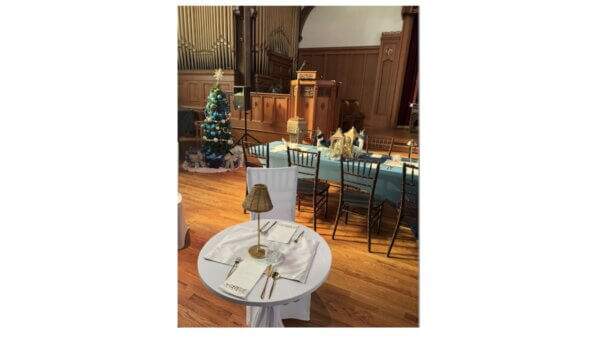Once known as Quaspeck by Indigenous peoples, Rockland Lake evolved from a seasonal fishing site into a key hub for ferry traffic, Revolutionary War activity, and 19th-century commerce. The Knickerbocker Ice Company transformed the area into a busy ice harvesting center, complete with a gravity-powered “ice train” that carried blocks to barges waiting on the Hudson.
When winter gave way to warmer months, the same workforce shifted to quarrying trap rock, feeding New York’s building boom. By the 1890s, Rockland Landing had become a busy industrial waterfront in the region—until environmental, economic, and technological pressures reshaped its future.
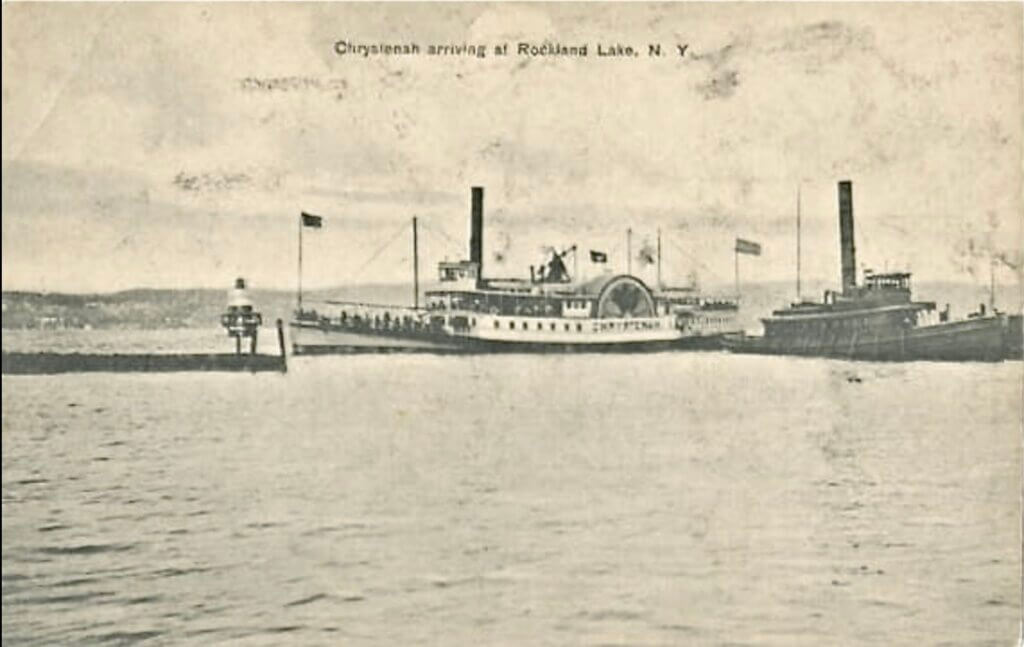
Wilson Foss: The Dynamite Baron
In 1891, explosives expert Wilson Foss—who had helped build the West Shore Railroad tunnel in Haverstraw—joined forces with Joseph E. Conklin to form the Manhattan Trap Rock Company. Foss, a fiercely competitive businessman, expanded the quarry into the region’s largest producer. He aggressively acquired nearby operations and resisted growing complaints about dust and blasting, including from the Rockefellers and others in Westchester County.

These complaints spurred the creation of the Palisades Interstate Park Commission (PIPC), which sought to buy and preserve the quarries as parks. Foss initially refused to sell but eventually agreed in 1917, securing a record price. His decision, while monetary, helped save the Hook Mountain complex from destruction.
Foss continued his mining ventures farther north, and many of his quarries are still in operation today under Tilcon. He became fabulously wealthy and built a mansion on North Broadway in Upper Nyack. When he died in 1930, newspapers called him the richest man in Nyack.
Navigating the Shoals: Why a Lighthouse Was Needed
Old-fashioned sidewheel steamboats could navigate shallow waters with ease, but propeller-driven steamboats required deeper channels. A large oyster bed just offshore from Rockland Landing—at a depth of 9½ feet—posed a hazard to these newer vessels. In addition arriving boats needed a lighthouse to help guide barges to the docks.
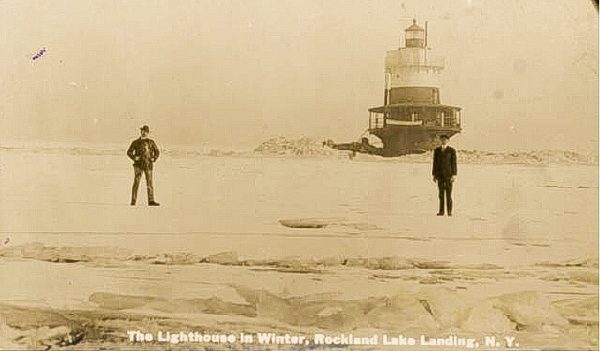
Although Congress authorized the lighthouse in 1889, workers didn’t begin construction until 1892. By 1894, they had completed a new lighthouse modeled on Tarrytown Light, positioned above the oyster bed. Crews drove its caisson 30 feet into the sediment, and the 50-foot tower rose with seven floors, topped by a fourth-order Fresnel lens.
The Leaning Light of Rockland Landing
Jonathan Miller served as the first lighthouse keeper, with Stephen Collyer as his assistant. Keepers staffed the lighthouse until 1923. Over time, the tower began to lean—whether due to erosion or its own weight is unclear. Rather than stabilize it, engineers adjusted the winding mechanism to work with the tilt.

With the lighthouse in place, downriver boats could pass Stony Point Light, then sight Rockland Light and align with Kingsland Point Light (now Tarrytown Light) before turning south. Upstream boats reversed this sequence.
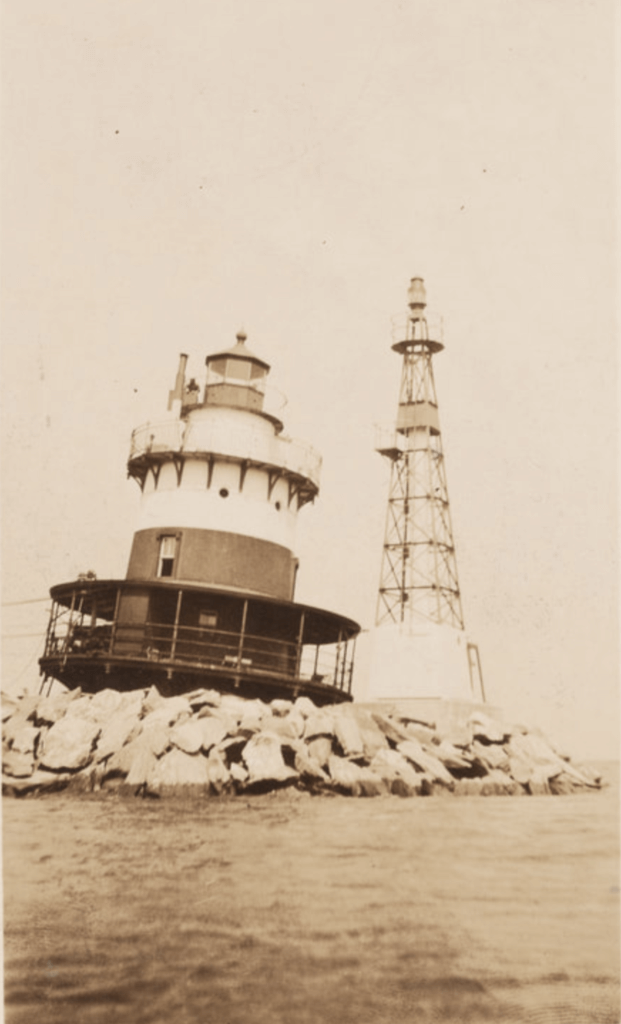
In 1923, the Coast Guard decommissioned and demolished the lighthouse. They replaced it with an unmanned red skeleton tower above a white tank—a navigational light that still marks the site today.
Reverting to Nature
With the rise of mechanical refrigeration, demand for natural ice declined rapidly. Rockland Lake’s ice operations ceased in 1924. In 1926, during demolition of one of the old ice houses, a fire broke out, fueled by sawdust once used to insulate the ice. The blaze destroyed the remaining ice houses and threatened buildings in Rockland Lake Village.
Quarry operations had already ended by 1916. The Palisades Interstate Park Commission (PIPC), which had acquired the deteriorating docks and Trough Hollow area, was uncertain about how to repurpose the land.
Hook Mountain Beach and WPA Development
In 1933, the PIPC began implementing plans to develop Hook Mountain and Nyack Beach State Parks. With the aid of WPA labor, they reshaped the old quarry lands at Nyack Beach, Rockland Landing, and Haverstraw Beach into recreational areas.

Because it had the largest docks, Rockland Landing. known as Hook Mountain Beach, became a key access point for day boats bringing city dwellers to the park, similar to Bear Mountain’s setup.
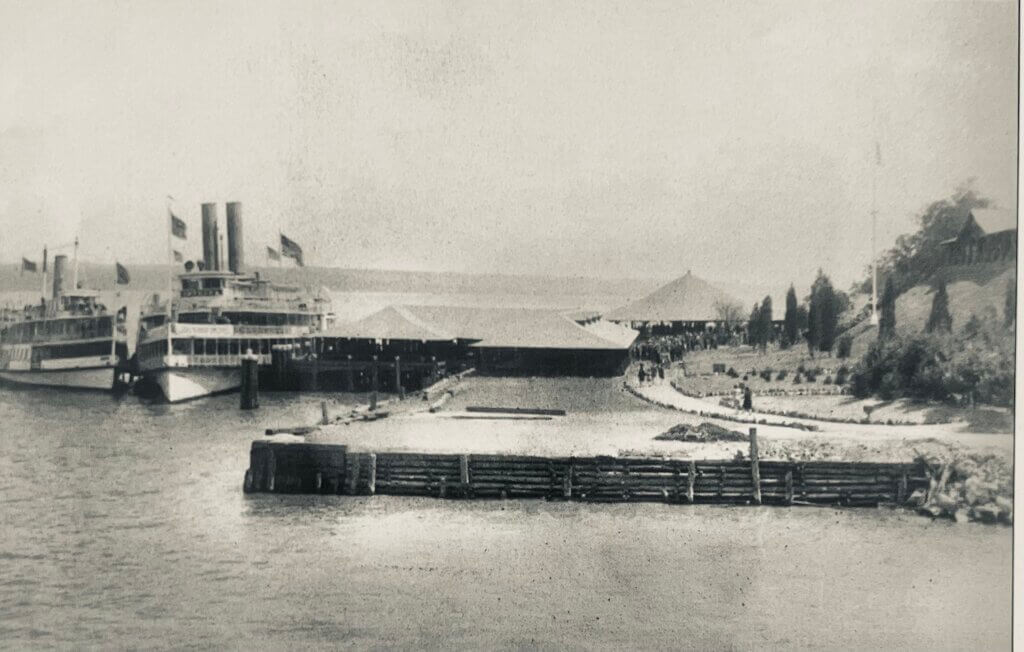
At Hook Mountain Beach, former quarry plateaus were repurposed into baseball fields and parking lots. A large restaurant at the end of a new road—built along the old incline railway—offered food and occasional lodging. Cars could drive down to a new parking area. The southern shore featured a roped-off sandy beach, dance hall, merry-go-round, and a children’s play area.
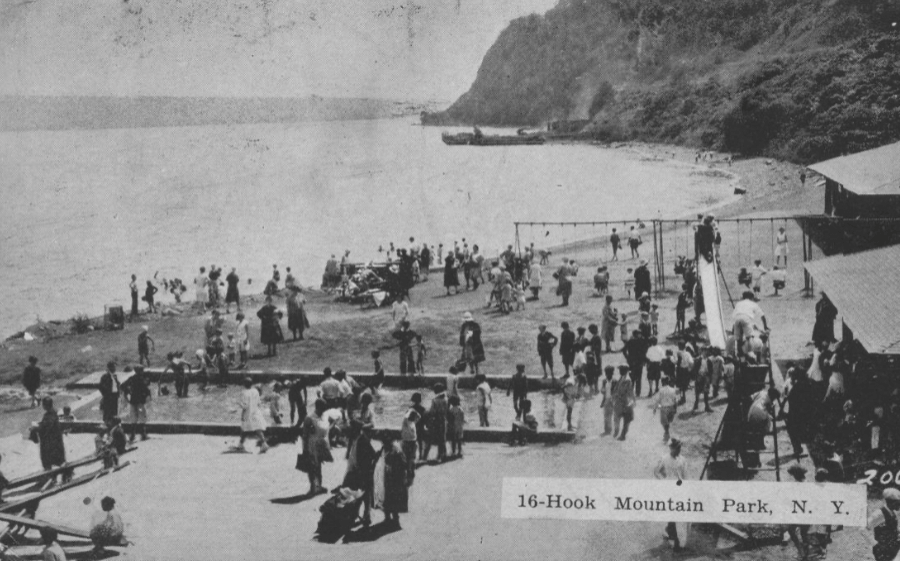
The beach, like many parks of the era, was segregated. Black visitors were confined to the area north of the docks. A walkway along the Hudson connected Hook Mountain Beach with Nyack and Haverstraw beaches and included restrooms and picnic spots.
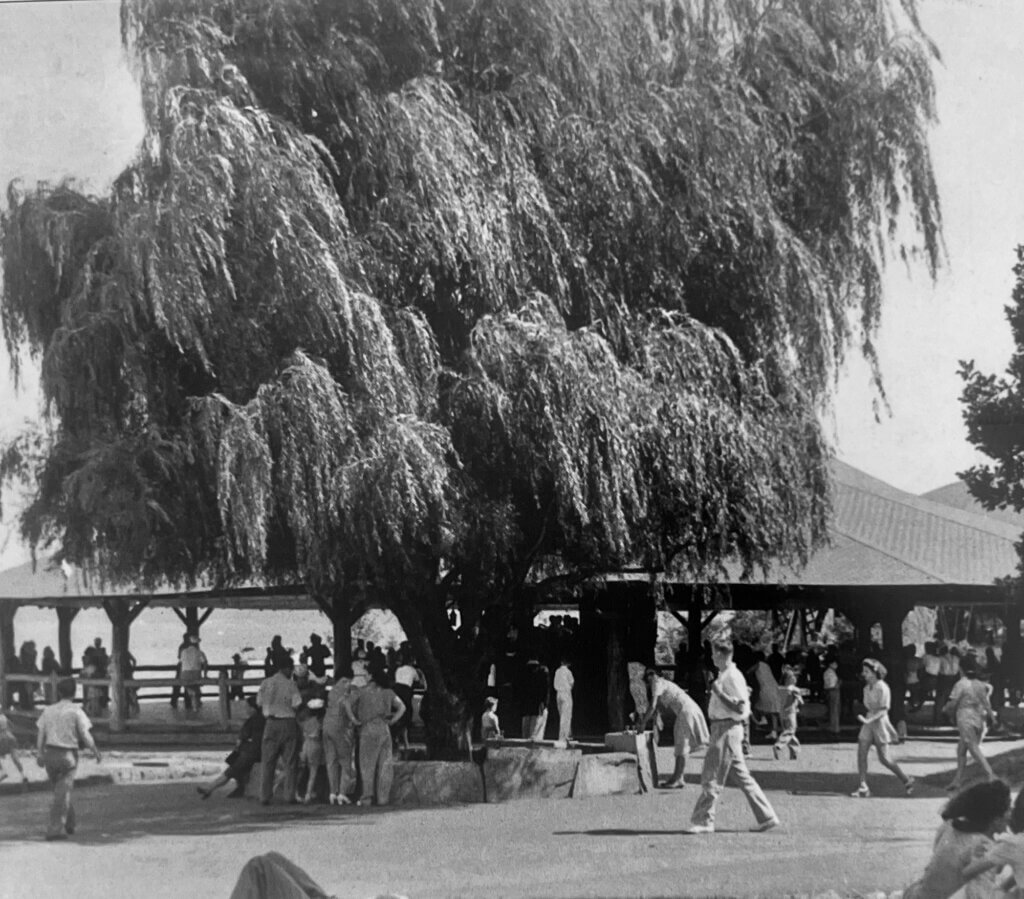
Sadly, a devastating nor’easter during Thanksgiving weekend of 1950 battered the shoreline. The storm demolished the Nyack docks including the old Nyack Rowing Association building. Fierce winds and water surge destroyed Nyack Beach’s dock and most of the amusements at Hook Mountain Beach. The area never returned to its brief heyday as a Hudson River amusement park.
Rockland Landing Legacy
Today, only a small triangular peninsula remains from the old landing. It holds a few picnic tables, and a walkway above the site connects to a driveway that leads to the lake—now restricted to PIPC vehicles. The remnants of the buildings still stand. Fragments of steel supports from the park era appear along the rocky shoreline.
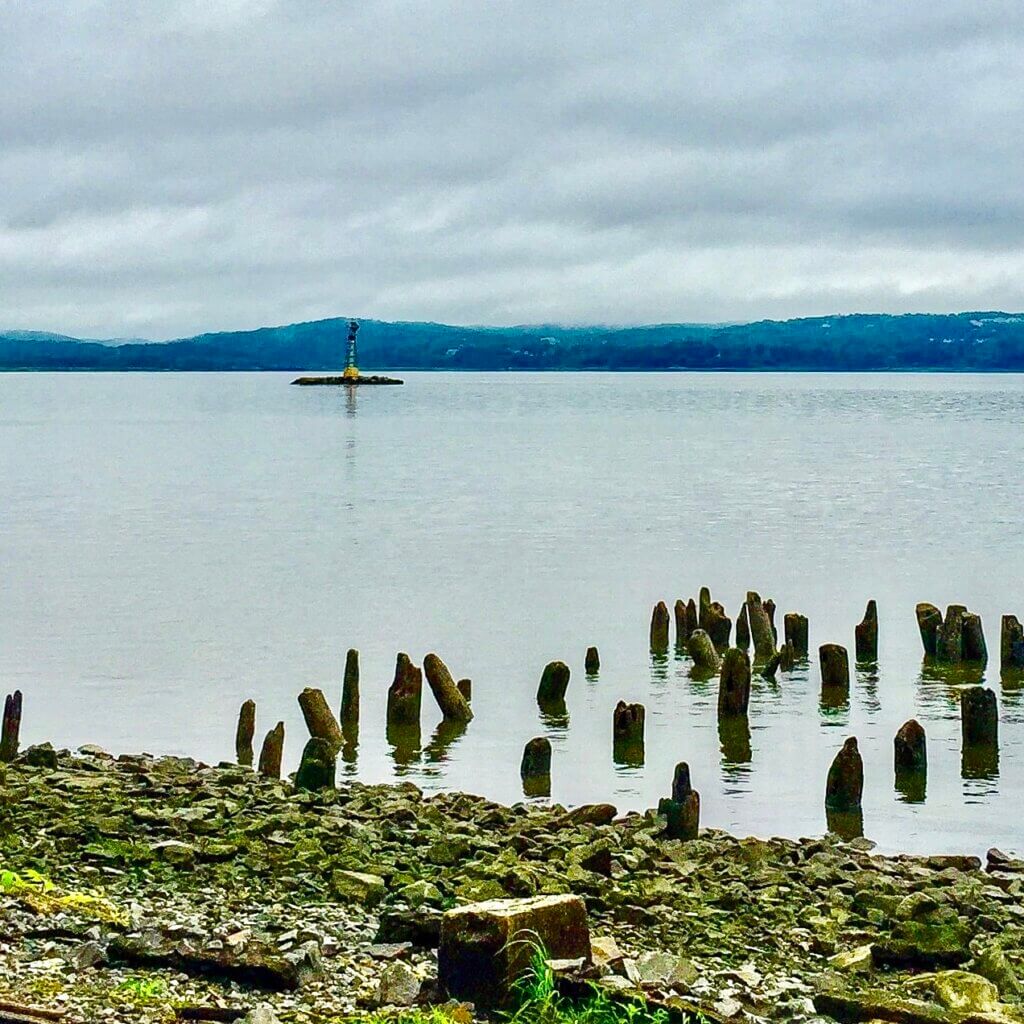
At the top of the Clove, the stone foundation of the former inclined railway is still visible. The ball fields, now overgrown with trees, and the quarry’s towering rock face remain mostly hidden by forest.
Most who pause here have no idea that this quiet place once bustled with industry, commerce, and recreation—first as a vital shipping and quarrying hub, and later as the site of a forgotten riverside amusement park.
Mike Hays lived in the Nyacks for 38-years. He worked for McGraw-Hill Education in New York City for many years. Hays serves as President of the Historical Society of the Nyacks, Vice-President of the Edward Hopper House Museum & Study Center, and Upper Nyack Historian. Married to Bernie Richey, he enjoys cycling and winters in Florida. You can follow him on Instagram as UpperNyackMike.
Editor’s note: This article is sponsored by Sun River Health and Ellis Sotheby’s International Realty. Sun River Health is a network of 43 Federally Qualified Health Centers (FQHCs) providing primary, dental, pediatric, OB-GYN, and behavioral health care to over 245,000 patients annually. Ellis Sotheby’s International Realty is the lower Hudson Valley’s Leader in Luxury. Located in the charming Hudson River village of Nyack, approximately 22 miles from New York City. Our agents are passionate about listing and selling extraordinary properties in the Lower Hudson Valley, including Rockland and Orange Counties, New York.






